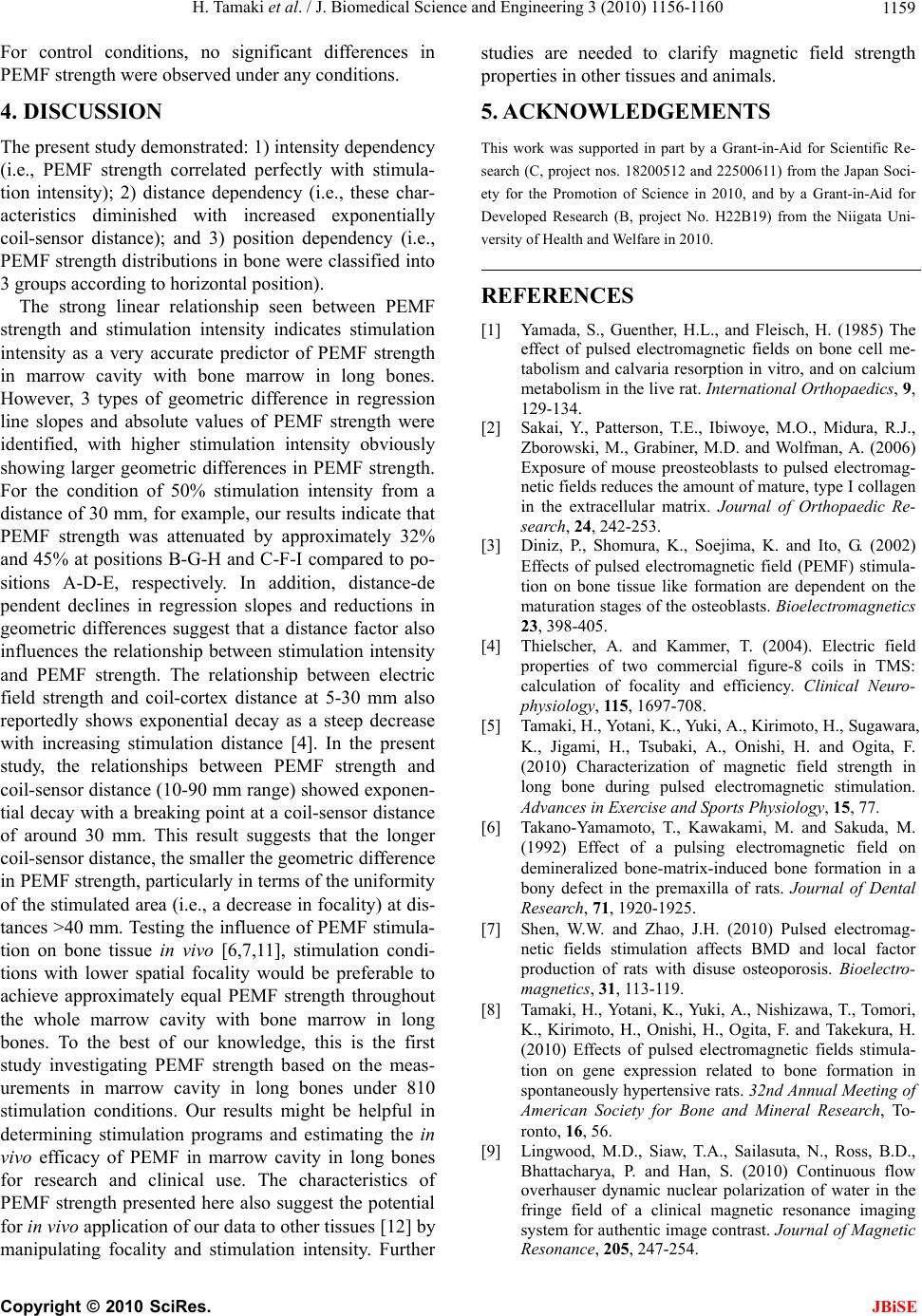
H. Tamaki et al. / J. Biomedical Science and Engineering 3 (2010) 1156-1160 1159
For control conditions, no significant differences in
PEMF strength were observed under any conditions.
4. DISCUSSION
The present study demonstrated: 1) intensity dependency
(i.e., PEMF strength correlated perfectly with stimula-
tion intensity); 2) distance dependency (i.e., these char-
acteristics diminished with increased exponentially
coil-sensor distance); and 3) position dependency (i.e.,
PEMF strength distributions in bone were classified into
3 groups according to horizontal position).
The strong linear relationship seen between PEMF
strength and stimulation intensity indicates stimulation
intensity as a very accurate predictor of PEMF strength
in marrow cavity with bone marrow in long bones.
However, 3 types of geometric difference in regression
line slopes and absolute values of PEMF strength were
identified, with higher stimulation intensity obviously
showing larger geometric differences in PEMF strength.
For the condition of 50% stimulation intensity from a
distance of 30 mm, for example, our results indicate that
PEMF strength was attenuated by approximately 32%
and 45% at positions B-G-H and C-F-I compared to po-
sitions A-D-E, respectively. In addition, distance-de
pendent declines in regression slopes and reductions in
geometric differences suggest that a distance factor also
influences the relationship between stimulation intensity
and PEMF strength. The relationship between electric
field strength and coil-cortex distance at 5-30 mm also
reportedly shows exponential decay as a steep decrease
with increasing stimulation distance [4]. In the present
study, the relationships between PEMF strength and
coil-sensor distance (10-90 mm range) showed exponen-
tial decay with a breaking point at a coil-sensor distance
of around 30 mm. This result suggests that the longer
coil-sensor distance, the smaller the geometric difference
in PEMF strength, particularly in terms of the uniformity
of the stimulated area (i.e., a decrease in focality) at dis-
tances >40 mm. Testing the influence of PEMF stimula-
tion on bone tissue in vivo [6,7,11], stimulation condi-
tions with lower spatial focality would be preferable to
achieve approximately equal PEMF strength throughout
the whole marrow cavity with bone marrow in long
bones. To the best of our knowledge, this is the first
study investigating PEMF strength based on the meas-
urements in marrow cavity in long bones under 810
stimulation conditions. Our results might be helpful in
determining stimulation programs and estimating the in
vivo efficacy of PEMF in marrow cavity in long bones
for research and clinical use. The characteristics of
PEMF strength presented here also suggest the potential
for in vivo application of our data to other tissues [12] by
manipulating focality and stimulation intensity. Further
studies are needed to clarify magnetic field strength
properties in other tissues and animals.
5. ACKNOWLEDGEMENTS
This work was supported in part by a Grant-in-Aid for Scientific Re-
search (C, project nos. 18200512 and 22500611) from the Japan Soci-
ety for the Promotion of Science in 2010, and by a Grant-in-Aid for
Developed Research (B, project No. H22B19) from the Niigata Uni-
versity of Health and Welfare in 2010.
REFERENCES
[1] Yamada, S., Guenther, H.L., and Fleisch, H. (1985) The
effect of pulsed electromagnetic fields on bone cell me-
tabolism and calvaria resorption in vitro, and on calcium
metabolism in the live rat. International Orthopaedics, 9,
129-134.
[2] Sakai, Y., Patterson, T.E., Ibiwoye, M.O., Midura, R.J.,
Zborowski, M., Grabiner, M.D. and Wolfman, A. (2006)
Exposure of mouse preosteoblasts to pulsed electromag-
netic fields reduces the amount of mature, type I collagen
in the extracellular matrix. Journal of Orthopaedic Re-
search, 24, 242-253.
[3] Diniz, P., Shomura, K., Soejima, K. and Ito, G. (2002)
Effects of pulsed electromagnetic field (PEMF) stimula-
tion on bone tissue like formation are dependent on the
maturation stages of the osteoblasts. Bioelectromagnetics
23, 398-405.
[4] Thielscher, A. and Kammer, T. (2004). Electric field
properties of two commercial figure-8 coils in TMS:
calculation of focality and efficiency. Clinical Neuro-
physiology, 115, 1697-708.
[5] Tamaki, H., Yotani, K., Yuki, A., Kirimoto, H., Sugawara,
K., Jigami, H., Tsubaki, A., Onishi, H. and Ogita, F.
(2010) Characterization of magnetic field strength in
long bone during pulsed electromagnetic stimulation.
Advances in Exercise and Sports Physiology, 15, 77.
[6] Takano-Yamamoto, T., Kawakami, M. and Sakuda, M.
(1992) Effect of a pulsing electromagnetic field on
demineralized bone-matrix-induced bone formation in a
bony defect in the premaxilla of rats. Journal of Dental
Research, 71, 1920-1925.
[7] Shen, W.W. and Zhao, J.H. (2010) Pulsed electromag-
netic fields stimulation affects BMD and local factor
production of rats with disuse osteoporosis. Bioelectro-
magnetics, 31, 113-119.
[8] Tamaki, H., Yotani, K., Yuki, A., Nishizawa, T., Tomori,
K., Kirimoto, H., Onishi, H., Ogita, F. and Takekura, H.
(2010) Effects of pulsed electromagnetic fields stimula-
tion on gene expression related to bone formation in
spontaneously hypertensive rats. 32nd Annual Meeting of
American Society for Bone and Mineral Research, To-
ronto, 16, 56.
[9] Lingwood, M.D., Siaw, T.A., Sailasuta, N., Ross, B.D.,
Bhattacharya, P. and Han, S. (2010) Continuous flow
overhauser dynamic nuclear polarization of water in the
fringe field of a clinical magnetic resonance imaging
system for authentic image contrast. Journal of Magnetic
Resonance, 205, 247-254.
Copyright © 2010 SciRes. JBiSE